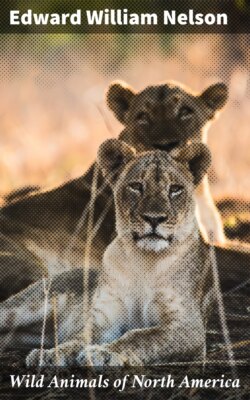Читать книгу Wild Animals of North America - Edward William Nelson - Страница 6
На сайте Литреса книга снята с продажи.
The Larger North American Mammals
ОглавлениеTable of Contents
By E. W. NELSON
Chief, U. S. Biological Survey
With Illustrations from Paintings by Louis Agassiz Fuertes
At the time of its discovery and occupation by Europeans, North America and the bordering seas teemed with an almost incredible profusion of large mammalian life. The hordes of game animals which roamed the primeval forests and plains of this continent were the marvel of early explorers and have been equaled in historic times only in Africa.
Even beyond the limit of trees, on the desolate Arctic barrens, vast herds containing hundreds of thousands of caribou drifted from one feeding ground to another, sharing their range with numberless smaller companies of musk-oxen. Despite the dwarfed and scanty vegetation of this bleak region, the fierce winter storms and long arctic nights, and the harrying by packs of white wolves, these hardy animals continued to hold their own until the fatal influence of civilized man was thrown against them.
Southward from the Arctic barrens, in the neighboring forests of spruce, tamarack, birches, and aspens, were multitudes of woodland caribou and moose. Still farther south, in the superb forests of eastern North America, and ranging thence over the limitless open plains of the West, were untold millions of buffalo, elk, and white-tailed deer, with the prong-horned antelope replacing the white-tails on the western plains.
With this profusion of large game, which afforded a superabundance of food, there was a corresponding abundance of large carnivores, as wolves, coyotes, black and grizzly bears, mountain lions, and lynxes. Black bears were everywhere except on the open plains, and numerous species of grizzlies occupied all the mountainous western part of the continent.
Fur-bearers, including beavers, muskrats, land-otters, sea-otters, fishers, martens, minks, foxes, and others, were so plentiful in the New World that immediately after the colonization of the United States and Canada a large part of the world’s supply of furs was obtained here.
Trade with the Indians laid the foundations of many fortunes, and later developed almost imperial organizations, like the Hudson’s Bay Company and its rivals. Many adventurous white men became trappers and traders, and through their energy, and the rivalry of the trading companies, we owe much of the first exploration of the northwestern and northern wilderness. The stockaded fur-trading stations were the outposts of civilization across the continent to the shores of Oregon and north to the Arctic coast. At the same time the presence of the sea-otter brought the Russians to occupy the Aleutian Islands, Sitka, and even northern California.
Photograph by Capt. F. E. Kleinschmidt
TOWING HER BABY TO SAFETY
When a mother polar bear scents danger she jumps into the water and her cub holds fast to her tail while she tows it to safety. But when no danger seems to threaten she wants it to “paddle its own canoe,” and boxes its ears or ducks its head under water if it insists on being too lazy to swim for itself.
The wealth of mammal life in the seas along the shores of North America almost equaled that on the land. On the east coast there were many millions of harp and hooded seals and walruses, while the Greenland right and other whales were extremely abundant. On the west coast were millions of fur seals, sea-lions, sea-elephants, and walruses, with an equal abundance of whales and hundreds of thousands of sea otters.
Photograph by Capt. F. K. Kleinschmidt
A SWIMMING POLAR BEAR
A polar bear when swimming does not use his hind legs, a new fact brought out by the motion-picture camera.
Photograph by Roy Chapman Andrews
FUR SEAL: FEMALES AND YOUNG PUPS
From the ages of one to four years fur seals are extremely playful. They are marvelous swimmers, and frolic about in pursuit of one another, now diving deep, and then, one after the other, suddenly leaping high above the surface in graceful curves, like porpoises.
Many of the chroniclers dealing with explorations and life on the frontier during the early period of the occupation of America gave interesting details concerning the game animals. Allouez says that in 1680, between Lake Erie and Lake Michigan the prairies were filled with an incredible number of bears, wapiti, white-tailed deer, and turkeys, on which the wolves made fierce war. He adds that on a number of occasions this game was so little wild that it was necessary to fire shots to protect the party from it. Perrot states that during the winter of 1670-1671, 2,400 moose were snared on the Great Manitoulin Island, at the head of Lake Huron. Other travelers, even down to the last century, give similar accounts of the abundance of game.
© Keystone View Co.
ROAMING “MONARCHS OF THE PLAIN”: BRITISH COLUMBIA
A remnant of the veritable sea of wild life that surged over American soil before the dikes of civilization compassed it about and all but wiped it out.
